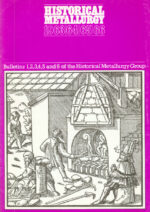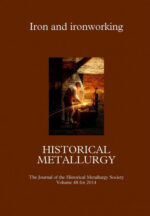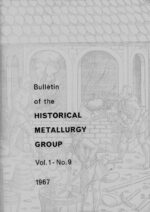Journal Contents
An examination of some early bronzes from Samreng Sen, Kampuchea
Robert E Murowchick
Pages 1-20
The development of metallurgy in Southeast Asia is only now just beginning to be pieced together by archaeologists from a number of nations, and the course of this development remains the subject of heated debate among scholars. The ancient metallurgy of Kampuchea is particularly enigmatic owing to the scarcity of data and the varying quality of the early excavations, a situation that will not be rectified in the near future. This paper will present the results of a metallurgical examination of several bronze artifacts said to come from the prehistoric site of Samreng Sen, Kampuchea, which are now in the collections of the Peabody Museum of Archaeology and Ethnology at Harvard University. Combining these analyses with other early metallurgical finds from the area, it is possible to make a tentative reconstruction of various aspects of early Kampuchean metallurgy.
Phosphorus in low carbon iron: Its beneficial properties
Martha Goodway and Robert M Fisher
Pages 21-23
Phosphorus is not commonly considered a beneficial element in iron, yet ferrous music wire of the 18th century contained significant amounts (0.1-0.2% P.) The documented methods of traditional wire making indicate that iron containing phosphorus was specially selected for wire drawing. Beneficial properties of phosphorus in low-carbon iron, such as ease of drawing and increased strength, were demonstrated by replication. It is concluded that phosphorus in ancient iron objects may not always be accidental but may on occasion occur by selection for improved properties.
Small amounts of phosphorus have long had a reputation for rendering iron brittle when worked cold, or ‘cold short’. In 1864 John Percy wrote that, “There is no fact relating to the metallurgy of iron which seems to be better established than this, and certainly there is not one which is more generally received as correct”‘. In 1918 Stead reported that “prominent metallurgists refer to phosphorus as treacherous”, and in 1920 a paragraph in a standard handbook, headed the “Two Evils of Phosphorus”, referred to “the treacherousness of phosphoritic steel”‘.
The Bristol brass industry: Furnace structures and their associated remains
Joan M Day
Pages 24-41
Remains of the once-extensive Bristol brass industry can still be seen at several sites on the banks of the Avon and its tributaries between Bath and Bristol. They are relics of the production of brass and its manufacture which flourished during the eighteenth century to become the most important industry of its kind in Europe, superseding continental centres of similar production. By the close of the century Bristol itself was challenged by strong competition and the adoption of new techniques in Birmingham, and thereafter suffered a slow decline. Still using its eighteenth-century water-powered methods the Bristol industry just managed to survive into the twentieth century, finally closing in the 1920s.
Andrew Yarranton and the British Tinplate Industry
Peter T Brown
Pages 42-48
The industrialist Andrew Yarranton was involved with a variety of projects which were designed to improve the English economy during the later 17th century’. Few of these projects were successful during their day, but one of the most noteworthy was his attempt to establish a tinplate industry in Britain. The standard works on this subject^ discuss his attempts at length, but further documentary evidence has since become available, rectifying certain popular misconceptions and providing additional detail. The aim of this paper is to present a reassessment of Yarranton’s contribution to the development of the industry, in the light of this fresh material.
This is the first of two papers on this subject, the second, by Peter King is in Vol 22 (2).
Melting points and viscosities of ancient slags: A contribution to the discussion
I C Freestone
Pages 49-51
The arguments levelled by Kresten against the calculation of viscosities and liquidus temperatures of slags from bulk chemical composition are refuted. Methods exist which allow the calculation of the viscosity and liquidus temperature of a multicomponent silicate liquid to an acceptable level of accuracy.
An historical note on the King's Norton Metal Company Limited
Richard Chadwick
Pages 52-64
Any history of King’s Norton Metal Company must begin with Thomas Richard Bayliss (1838-1914), its founder and director. Bayliss in 1862 married the daughter of John Abraham, who in that same year established the Adderley Park Mills in Saltley, Birmingham where, in addition to the production of brass and copper rolled strip, machinery was installed for making percussion caps, and other drawn products for the ammunition trades. Under the direction of Bayliss the ammunition business was further developed, and plant was designed to produce deep drawn brass cases for military small arms ammunition. In 1873 the Adderley Park Mills were acquired by the Birmingham Small Arms Company. There Bayliss, as managing director, brought cartridge case manufacture onto a production basis, and in the late 1870s was instrumental in the supply of 50 million rounds of 0.303in ammunition for the then new German Mauser rifle. Bayliss also personally supervised the installation of plant in Germany for further manufacture.






There are no reviews yet.